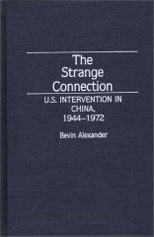The Strange Connection: U.S. Intervention in China, 1944-1972
 Click here to purchase from Barnes & Noble.
Click here to purchase from Amazon.com.
Click here to purchase from Barnes & Noble.
Click here to purchase from Amazon.com.
Introduction
This book traces the beginnings of American interference in China's affairs in 1944, the unsuccessful mission of George C. Marshall to create a coalition Red-Nationalist government, the acceptance of Taiwan as an American protectorate at the beginning of the Korean War, the adoption of a national resolve to destroy the Chinese Communist state, the close brush with nuclear war over possession of the offshore islands of Quemoy and Matsu and the eventual rapprochement with Red China when President Richard Nixon visited Beijing in 1972.
By taking on the cause of the oppressed and poor who formed 95 per cent of China's population, the Communist party guaranteed itself ultimate domination. The West failed to see the necessity for this vast popular upheaval and believed Chinese Communism was only a subversive branch of expansive world Communism ruled from the Kremlin. This misconception led Americans into unreasoning opposition, when the only reasonable solution was to come to terms with the Reds.
In the early years of its intervention, the United States supported the reactionary Nationalist regime in opposition to the Communist challenger. When this effort failed, the United States remained hostile for a generation to the victorious Communists. This led to one war, the threat of another war and a decades-long emphasis on the wrong enemy at a time the U.S. faced immense danger from the Soviet Union.
The American experience with China illustrates that nations ignore at their peril policies which run counter to their national interests. A nation need not love another nation to deal with it. A nation may despise another nation's ideology yet still gain what it seeks from that nation. The U.S. wisely applied this policy to the Soviet Union but did not to China.
Communist China, despite American repugnance for its beliefs, would have cooperated with the U.S., given the chance, in its primary aim in East Asia: keeping the peace. China desired the identical aims the United States espoused in this region. These included holding the Soviet Union at a distance, discouraging aggression and encouraging international trade. Red China never pursued expansive policies against other East Asian nations, despite much U.S. propaganda to the contrary.
One of the most anti-Communist presidents in American history, Richard Nixon, realized that U.S.-induced exclusion of China from the United Nations and U.S. refusal to recognize the People's Republic were achieving little. He saw that China could be changed from the outside only by means of a great nuclear war that no sensible person was willing to pursue. In his visit to China, Nixon finally brought the U.S. to accept the Chinese revolution and at last to begin treating China as a nation among nations. The United States has followed this policy since.
<< More on 'The Strange Connection' << Back to top